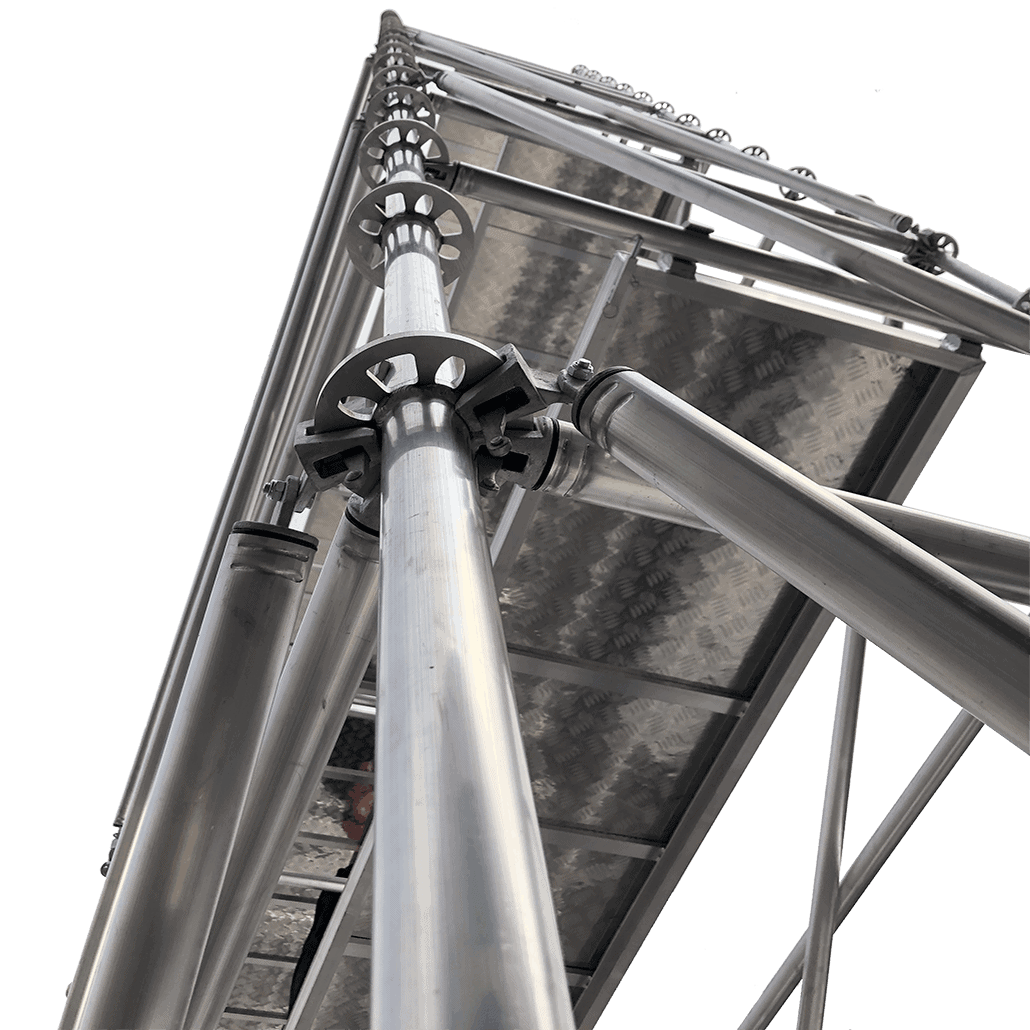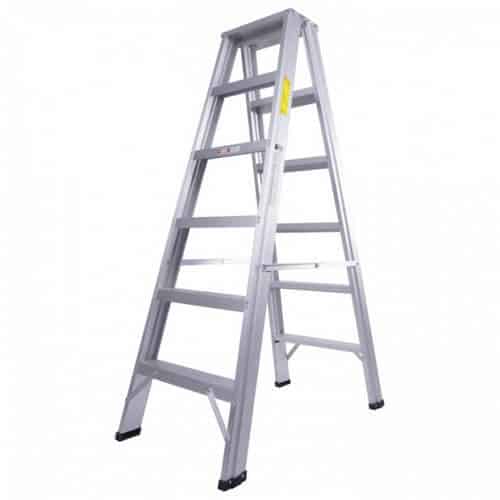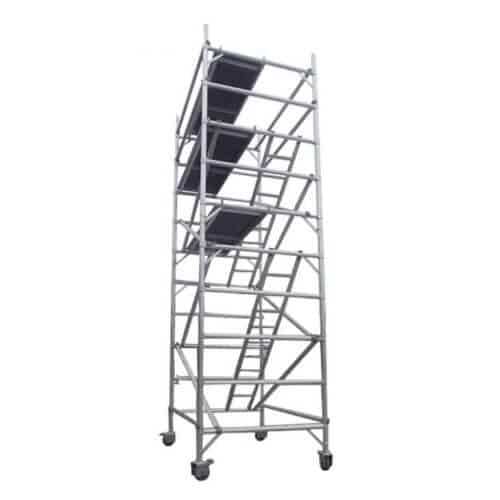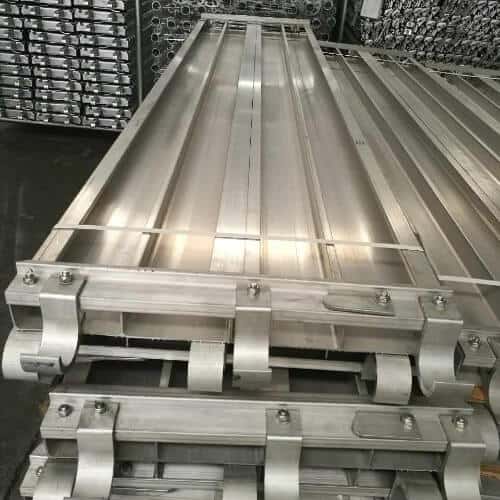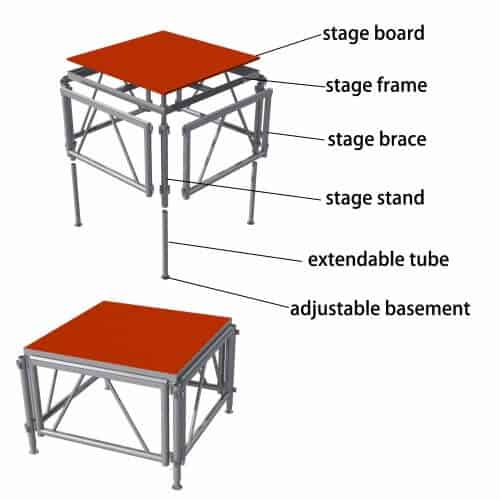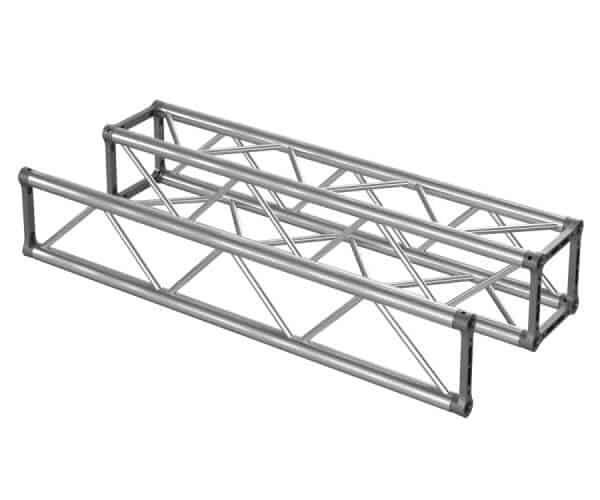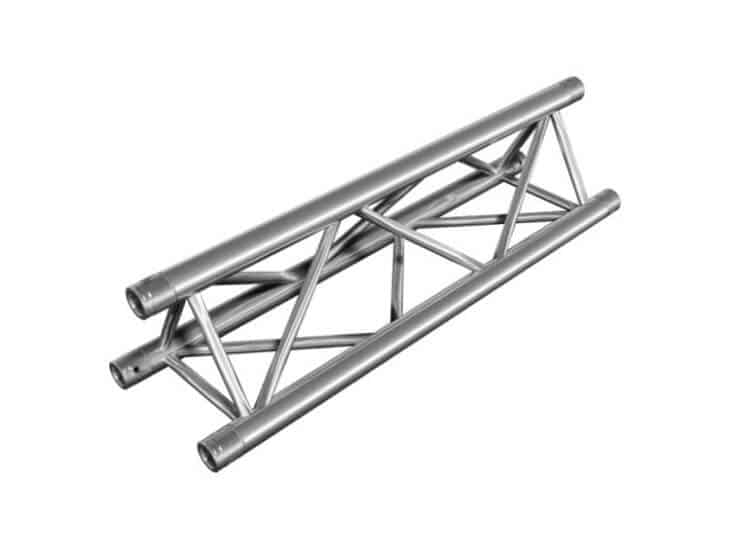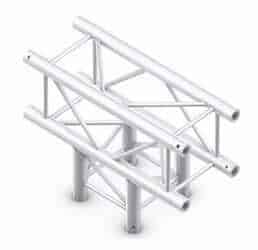Aluminum Scaffolding
Total Contec is a leading aluminum scaffold Manufacturer in China which mainly engaged in the development and production of aluminum scaffoldings, namely aluminum tower, aluminum truss, aluminum ladder and plank, aluminum frame, special aluminum alloy profiles and other products.
Aluminum Scaffolding Video
Aluminum Scaffold – The Complete FAQ Guide
You’ll find many different materials used in a scaffolding system, but the most common ones include bamboo, carbon steel, stainless steel, and of course – aluminium. Out of all these, aluminum scaffolds have been determined and identified as one of the best, more efficient, and safer types of scaffolding systems, and we built this guide to help and tell you why!
In this FAQ guide, we’ll go about providing why high-quality aluminum scaffolds are sought-after, their pros and cons, where they’re used, and of course, where you can get them!
Contents
- Aluminum Ladder
- Aluminum Tower
- Aluminum Plank
- Aluminum Stage
- Aluminum Bolted Truss
- Aluminum Spigot Truss
- Aluminum Truss Accessories
- Aluminum Scaffolding Video
- Aluminum Scaffold – The Complete FAQ Guide
- What is Aluminum Scaffolding?
- Is Aluminum a Type of Scaffolding Steel?
- What Other Materials Can Be Used For Scaffolding?
- Wood
- Bamboo
- Fiberglass
- Steel
- Where is Aluminum Scaffolding Used?
- Pros of Using Aluminum Scaffolding
- Lightweight
- Easy to Use
- Easy to Maneuver
- Stable and Adaptable
- Safe and Secure
- Cons of Using Aluminum Scaffolding
- Expensive and Costlier Than Most Materials
- Less Load Carrying Capacity
- How High Can You Build Aluminum Scaffolds?
- What is a Birdcage Scaffold?
- Parts of Aluminum Scaffolding
- Mobile Aluminum Scaffolding
- How to Choose Your Aluminum Scaffolding
- Factor #1: The Manufacturer
- Factor #2: Features and Benefits
- Factor #3: Inclusions
- Factor #4: Price and Cost
- Aluminum Scaffolding Tower
- Aluminum Scaffolding Rental
- Which Aluminum Scaffolding Manufacturer Can You Trust?
What is Aluminum Scaffolding?
Aluminum scaffolding is a type of scaffolding structure that refers to any style whereas the material used is aluminum. It can be anything from pre-fabricated frame scaffolds, ringlock scaffold, cuplock scaffold, HAKI scaffold, or any other type so long as the material used is aluminum.
By this alone, you’d already know aluminum scaffolding when you see one.
Is Aluminum a Type of Scaffolding Steel?
No, it is not – let me explain. Aluminum is a type of non-ferrous metal, joining forces with other non-ferrous metals such as tin, copper, titanium, lead, zinc, etc. Steel (as well as all other types of steel) on the other hand are considered ferrous metals.
This simply means that steel – carbon steel, alloy steel, stainless steel, etc., contain abundant amounts of iron, whereas non-ferrous materials – like aluminum, do not.
Now that we know this, let us then discuss other different materials used for scaffolding.
What Other Materials Can Be Used For Scaffolding?
Manufacturers all over the world are accustomed to using the materials they have already used before. This is the reason why a lot of them aren’t really versatile and flexible when it comes to the choosing or selection of materials.
For this particular reason, we here at Total Contec capitalized on this. We’re able to produce the scaffolding system you need regardless of the material you’re looking at!
Going back, other materials that scaffolding manufacturers make use of are:
Wood
Topping the list, of course, would be wood. Now, this is different from bamboo since it’s a different breed or classification of wood. Traditional companies make use of wood for their basic and simple tower-like scaffolding systems.
NOTE: Commonly, pine and fir are two (2) of the most common wooden materials used in scaffolding. Of course, this type of scaffolding is double-checked and reassessed before operations to ensure that it’s eligible for use.
Bamboo
Typically and traditionally used in Hong Kong and selected regions in China, bamboo scaffolding is an ancient component of ancient construction. It’s deemed to be a strong, durable, and highly-effective type of scaffold because of the flexibility and overall strength of the bamboos.
Fiberglass
Fiberglass is one of the lesser-known materials used in the scaffolding industry. The reason for this is because of its uniqueness and overall independence. Unlike steel, wood, aluminum – all those kinds of stuff, fiberglass is not a material that can easily be sourced out. Nevertheless, it’s still used by some companies, especially in high-temperature and involuntary situations.
Steel
Last and most probably the most common and most-known material, which is steel. Steel can be used in many different forms, but the most popular variant of steel used in construction or scaffolding, in particular would be stainless steel and carbon steel. These 2 types of steel can easily be gotten and purchased, not to mention their durable properties, too!
These are the common materials that are used by manufacturers and distributors of scaffolding systems other than aluminum! Each of them has their own benefits and advantages, so be sure to check and study them first!
Where is Aluminum Scaffolding Used?
Aluminum scaffolding is known as one of the most common types of scaffolding simply because of how flexible and versatile it is. That being said, it’s pretty clear that aluminum scaffolding can be used in various business sectors and industries, including:
- Interior and exterior projects
- Residential, industrial, and commercial
- Engineering and construction
- Oil & gas industries
- Automotive and aerospace sector
- And many more!
NOTE: Of course, these are only the more common and popular types of applications and industries that make use of aluminum scaffolding. There are far more businesses and sectors that can make use of it – so, if you don’t see the type of project you have here, don’t come to the conclusion that aluminum scaffolding wouldn’t be allowed!
Pros of Using Aluminum Scaffolding
Compared to other materials and types of scaffolding, aluminum scaffolds have various pros, advantages, and benefits. These include:
Lightweight
Probably the most identified factor and advantage of aluminum scaffold is the fact that it’s lightweight. Unlike fiberglass and other solid types of steel, aluminum is easy and lightweight. Their profile is that they’re highly portable because of how light and workable they are.
Easy to Use
Aluminum is such easy to use because of the fact that they are not heavy! All of its components will drastically be lighter and more workable compared to other types of material. This ease-of-use extends to better and higher quality compared to other materials that are less workable and less efficient.
Easy to Maneuver
If there are a couple of miscalculations on how you did your scaffolding, with aluminum scaffolding, you won’t have a problem. Since they’re lightweight and easily portable, you can easily maneuver and modify how it’s positioned and angled.
Stable and Adaptable
Aluminum scaffolding systems take pride on how stable and adaptable they are. However, this comes at a cost of maximum precision and accuracy in terms of the positioning and angling. A minor misalignment or miscalculation will put workers and personnel at risk of accidents like falling, slipping, or worse – dismantling of the scaffold.
Safe and Secure
Nevertheless, aluminum scaffolding systems are highly secure in terms of how they’re set up. Made up of a wide range of components that are purposely made for added weight and support, you’ll never have a problem with aluminum scaffolding if you’re worried about security.
These are just some of the most notable advantages of aluminum scaffolding. Of course, you’ll find more of them when you start using them on a day-to-day basis,
Cons of Using Aluminum Scaffolding
You can easily draw out the cons and disadvantages of aluminum scaffolding by looking at the benefits of it alone. For the benefit of everyone, though, here are some of the cons and drawbacks of using aluminum scaffolding
Expensive and Costlier Than Most Materials
Probably the major disadvantage of aluminum scaffolding is the fact that it is expensive and costlier compared to metal or other types of scaffolding. Because of its profile, its price-point per unit is way more expensive compared to usual stainless steel and carbon steel.
Less Load Carrying Capacity
Another drawback is that the weight it can carry is a lot less than what steel can. It is strong, flexible, and durable as it is, but how it can carry weight is a lot different – in fact, weaker compared to steel.
As you can see, the pros or advantages overpower the cons or disadvantages of using aluminum scaffolding systems. While you might think it’s something that doesn’t necessarily affect how it’s beneficial, when you do the math – you will eventually need to consider it.
How High Can You Build Aluminum Scaffolds?
Aluminum scaffolding, as per the Occupational Safety and Health Administration or OSHA, can be built up to a maximum height of 12 meters or about 39.4 feet.
For scaffolding heights that would be above 125 feet or about 38 meters, a licensed and certified engineer will be required to check and assess it before operations.
What is a Birdcage Scaffold?
A birdcage scaffold is a type of independent scaffolding system that’s comprised of 2+ rows of standards that are positioned in both directions, linked and attached via the transoms and the ledgers. Think about a birdcage but instead of having a circular upper portion, it’s sided (squared and/or rectangular).
Birdcage scaffolds are typically used in projects that are on a single level like ceilings, balconies, roofs, etc.
Parts of Aluminum Scaffolding
Just like other scaffolding classifications, aluminum scaffolding is made up of different parts and components. And to help you, these parts and components are:
- Horizontal Brace (Ledger)
- Stabilizer
- Vertical Brace (Standard)
- Diagonal Brace
- Toe Boards
- Ladder Frames
- Staircase (Ladder)
NOTE: All of these parts and components are made from aluminum. Therefore, you wouldn’t have to worry about corrosion, oxidation, as well as easy wear and tear as aluminum is an extremely resistant material against all of these.
Mobile Aluminum Scaffolding
There is what we call mobile aluminum scaffolding systems. These are the scaffolding structures that are equipped with wheels (casters) so that they can be pushed, pulled, relocated, and readjusted within the vicinity.
Mobile aluminum scaffolding is the solution to large-scale scaffolding requirements and projects that require multiple supported scaffolding .
How to Choose Your Aluminum Scaffolding
Not sure how you can choose the correct aluminum scaffolding you need for your project? Don’t worry, here’s a brief but concise guide on what you need to consider when choosing or purchasing an aluminum scaffold.
Factor #1: The Manufacturer
A lot of people don’t think about the manufacturer or the supplier of the scaffolding system they are about to purchase from, when in fact, this is the most important factor. Check their history, talk to clients and businesses they’ve sold to and serviced and ask about how effective they are in the field.
This can not only save you wasted time, but it can also give you the assurance of the company or the manufacturer you’ll be working with.
NOTE: If they have a website, try to check their level of customer service by sending them a message or by giving them a call.
Factor #2: Features and Benefits
Most, if not all manufacturers add features and benefits on top of the aluminum scaffolding offers they have. These features might not be particular to the price or even to your scaffolding – it can also be added components you can get for free or for discounted rates and prices.
NOTE: Check if the manufacturer you’ll be purchasing from offers discounts and promotional offers when you ask them for installation. Most scaffolding providers offer free installation, but it’ll still best for you to check.
Factor #3: Inclusions
Following the features, double-check the inclusions of the business you are about to get. In China, you’ll find tons of scaffolding manufacturers and companies – so, they’re selling point would be with their inclusions and promotions.
Factor #4: Price and Cost
Lastly, you need to factor in and consider how much you’ll be paying for. As we know, aluminum scaffolding is quite costlier and more expensive than the usual steel scaffolding. However, that doesn’t necessarily mean that everything will be at the same price.
Try finding the best deals without actually going too low to the extent that it could already be a scam or that it could be lower than what you expect.
Aluminum Scaffolding Tower
An aluminum scaffolding tower is one of the simplest and most basic forms of aluminum scaffolding. It is simply a single-line scaffold that can extend up to 12 meters (38 feet). Typically, this is the type of scaffolding used in residential and commercial buildings that are no more than 3-stories high.
Aluminum scaffolding towers are also utilized as some type of scaffolding support for another scaffolding system (i.e., suspended scaffolding).
Aluminum Scaffolding Rental
If you think you don’t need to purchase scaffolding for your business, then, you have the option to rent or lease it. You need to consider the length and timeline of your project before you pursue the rental simply because your contract might end or finish without the project being actually concluded.
Which Aluminum Scaffolding Manufacturer Can You Trust?
If you are in China and you can’t find a trustworthy and reliable aluminum manufacturer, then you’re just in the right guide! We here at Total Contec have been globally recognized as China’s most trusted and most reliable aluminum scaffolding supplier, servicing businesses, companies, and organizations worldwide!
Our scaffolding expertise allowed us to hone our overall skills, leading to the best and highest quality of aluminum scaffolding we can ever get.
Other than our aluminum scaffolding, Total Contec , you can also trust us here at Total Contec if you need modular scaffolding, HAKI scaffolding, formwork shoring props, Kwikstage scaffolding, and many more!
Don’t hesitate to reach out to us should you be in dire need of an aluminum scaffold set for your site!
We’ll give you a free quotation of all the services you need! Dial us or shoot us a message and we’ll be right with you!

